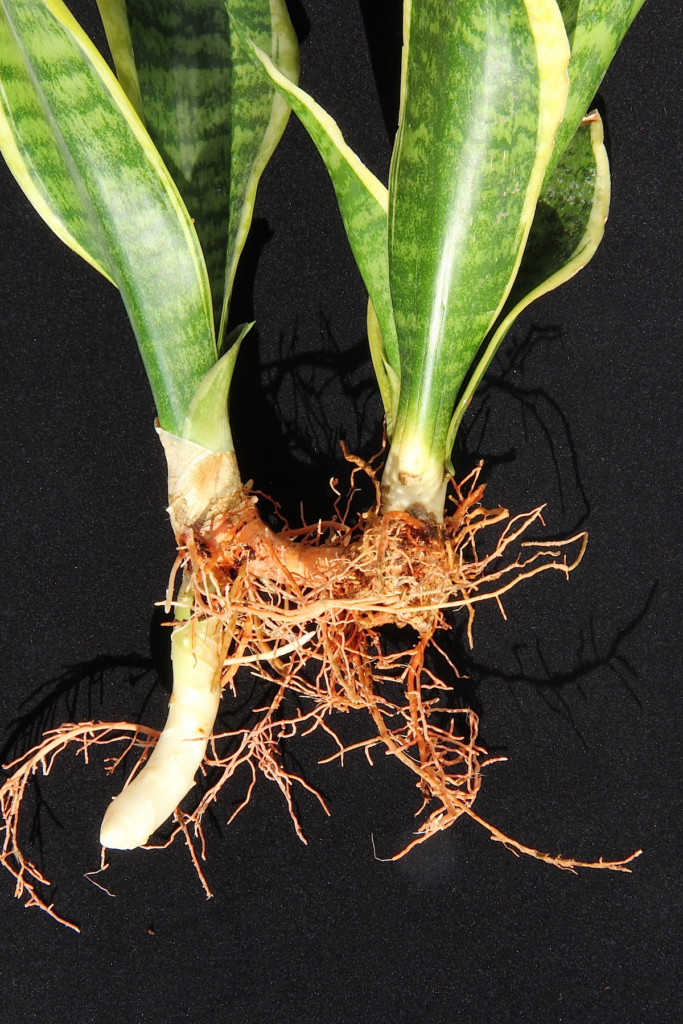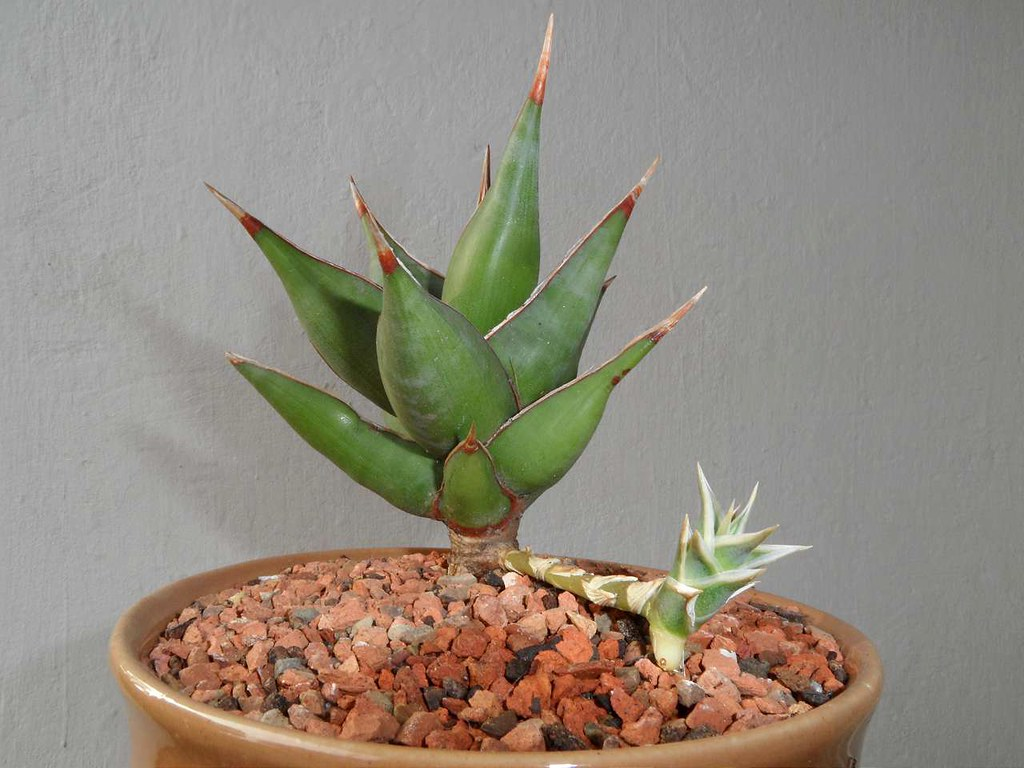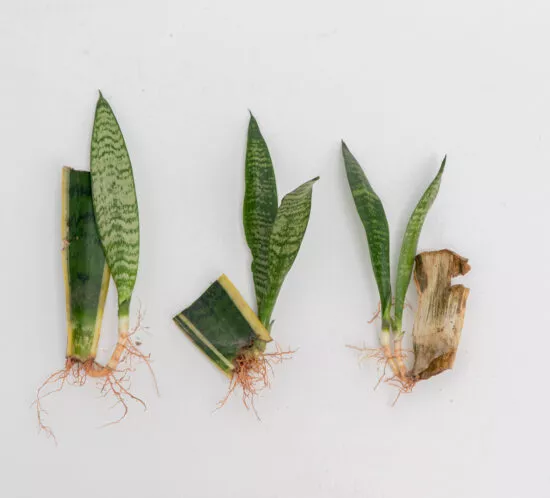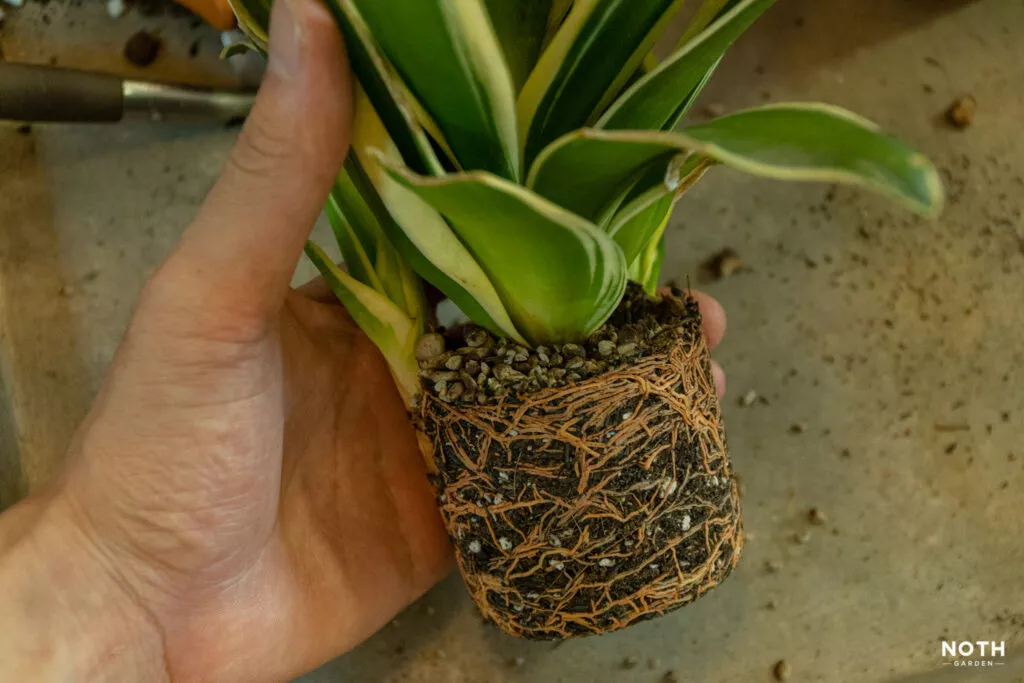You might have observed that your Snake Plant’s root system differs significantly from the root systems of your other plants if you’ve recently transplanted it to a new pot. You may be trying to figure out if what you’re seeing is typical. You can learn all about a snake plant roots in this article, including how they develop and how to spot problems.

Rhizomes, which are substantial underground “stems,” and smaller, twig-like roots make up the root system of a snake plant. They ought to be firm to the touch and pale orange in color when they’re in good health. Snake Plant rhizomes prefer to grow outward rather than down into the pot, thus, their roots rarely go deeper than a few inches.
Root rot, a fatal condition that frequently comes from persistent overwatering, is the primary health concern to be on the lookout for. Affected roots have a mushy texture and turn brown, gray, or black.
They could also emit a foul odor. We’ll describe how to identify and address this issue and offer some advice on maintaining the robust health of your snake plant’s roots.
What Are The Characteristics Of Healthy Snake Plant Roots?

Most likely, you don’t frequently look at the roots of your snake plant. These plants don’t require frequent repotting and grow fairly slowly. So you might be startled by what you discover when you finally pop it out of the ground.
The color is the first distinctive quality. The roots on your snake plant will likely be vivid orange, unlike the majority of houseplant roots, which are typically white or khaki in hue. It’s not a symptom of ill health, so don’t be alarmed! It’s normal for this color to exist.
The presence of thick tubers among the smaller, stringier roots may also strike some people as unusual. However, when examined more closely, you’ll see that all of your plant’s leaves grow from these thicker pieces.
Rhizomes, which are larger structures, are a typical characteristic of snake plants. Your Sansevieria does not have above-ground stems, unlike many succulents. Instead, until they locate a favorable location to sprout some leaf, their rhizomes travel through the soil. This aids these plants’ natural colonization of their surroundings even when they are unable to generate seeds.
This is one of the reasons Sansevierias are so simple to multiply. You can easily make a clone of your existing plant by cutting a rhizome from the main root mass and planting it in a new container.
How Far Down Do Snake Plant Roots Grow?
The roots of your snake plant seem incredibly shallow, which is the third thing you might have noticed. Why isn’t your plant making use of the space you’ve provided it? It has a good deep pot packed with excellent soil.
Again, this is typical behavior for snake plants. Their natural habitats frequently have sandy, rocky, and scant soil. They have therefore evolved to spread out rather than down. As a result, a Sansevieria frequently stays in the top 3 to 4 inches of soil and never explores the deeper layers.
This growth pattern may result in unforeseen challenges. For starters, many varieties of snake plants can reach heights of more than 3 feet. They may be top-heavy and prone to tipping over due to their height in combination with their shallow root systems. We advise selecting a container that is pretty deep, but don’t fill it all the way up; you should only need 4-6 inches of potting soil.
Another potential problem is that as your snake plant’s rhizomes spread out, they may put strain on or even shatter the container’s edges. Again, the only way to prevent this is to monitor your Sansevieria’s growth and divide it or pot it up into a bigger container as needed.
Related: How To Propagate A Snake Plant: What You Need To Know
How To Identify Unhealthy Sansevieria Roots

How can you tell whether the roots of your snake plant are unhealthy? When the roots aren’t working properly, the foliage often becomes shriveled, discolored, soft, and droopy, giving you a hint about the situation. However, to get a certain diagnosis, you must remove the plant and inspect “under the hood.”
The most typical problem to watch out for is root rot, as we mentioned in the introduction. This occurs when the soil is left damp for an extended period of time, allowing fungi and bacteria to proliferate in large numbers and infect the roots of your plant.
Roots that have been harmed change color to a dark brown or black and become floppy, slimy, and squishy. Depending on the types of bacteria attacking your plant, they could also smell awful, like vinegar, eggs, rubbish, or even raw sewage.
To rescue a snake plant that has root rot, you need to remove every single diseased root, sterilizing your trimmers between cuts with 10% bleach or 3% hydrogen peroxide. After that, place it in a tidy pot with new soil.
Fertilizer burn is the other issue to watch out for. As the name implies, this typically occurs when you add too much synthetic fertilizer, although tap water that is mineral-rich over time might have the similar effect. Due to osmotic pressure from the high concentrations of mineral salts around them, fertilizer burn causes the roots to become dehydrated. As a result, they’ll end up seeming crunchy and shriveled.
By draining the soil of your snake plant every 6 to 8 weeks, you can lessen the likelihood of fertilizer burn. Once you’ve used at least four times the volume of the container holding your Sansevieria, soak it carefully while letting the water drain out the pot’s bottom.
Other Signs Of Unhealthy Plant Roots
Lack of new leaves, fading color of foliage, and wilting can be signs of poor Snake plant roots. If your snake plant displays these signs, it might be time to transplant it or give it fertilizer.
Overwatering is the primary cause of unhealthy Snake plant roots. Lack of oxygen causes root rot and browning of the leaves because the roots are not receiving enough oxygen.
You should also watch out for the following signs of diseased Snake plant roots:
Other Signs Of Unhealthy Plant Roots
Lack of new leaves, fading color of foliage, and wilting can be signs of poor Snake plant roots. If your snake plant displays these signs, it might be time to transplant it or give it fertilizer.
Overwatering is the primary cause of unhealthy Snake plant roots. Lack of oxygen causes root rot and browning of the leaves because the roots are not receiving enough oxygen.
You should also watch out for the following signs of diseased Snake plant roots:
Leaves Turning Brown Or Yellow
The plant’s roots are struggling early on when its leaves turn yellow or brown. Because snake plants are already slow-to-medium growing plants, this is the cause.
Sansevieria plant roots that are yellow are clear indicators of root rot. The root rot first affects the outer leaves, and later, it spreads to the rest of the foliage.
More information about yellowing Snake Plants is available here.
Leaves Wilting Or Drooping
Roots with damage result in wilty or droopy leaves. Typically, they deteriorate, turn yellow, and eventually detach from the plant. The snake plant roots need to be amended since wilting and drooping plants are obvious signs that they are sick.
Roots That Have Become Black And Mushy
Examine the plant’s roots thoroughly. White or light yellow roots indicate healthy roots. To touch them feels solid. But diseased roots become limp and gradually turn black or brown when they are exposed to the disease. They have a slightly mushy and soft texture.
The healthy part of the roots becomes darker and mushy as the root rot turns to fasten itself, and eventually dies. When you pull on damaged roots, they may even come off the plant.
Appearance Of Soil
Too much time spent in wet soil might lead to root rot. Put your finger in the soil and feel how moist it is to determine whether the soil is the source of the root rot.
Feel the dirt at least two inches below the surface. If it’s still damp even after several days of watering, something is wrong. An alternative is to utilize a soil-measuring device.
What Causes Unhealthy Snake Plant Roots?
The primary factor causing root rot in snake plants is an excess of water at the roots. Water can build up around a snake plant’s root zone for a variety of causes, while overwatering is one of the problems that might result from this. The first step in healing your snake plant and preventing future root rot is to identify the specific cause of its waterlogging.
Here are some of the common causes of problematic snake plant roots:
- Overwatering
- Inefficient Soil Drainage
- Incorrect Pot Size
- Cold Temperature
- Fungal or Bacterial Disease
Read more about the common problems of Snake Plants and how to fix them.
How To Root Your Snake Plant Cuttings

Propagating snake plants can be a fun and enjoyable task. To propagate snake plants, you can use snake plant leaf cuttings or rhizome cuttings. Either of two methods does not need technical knowledge and is fairly easy to do so.
To propagate a Snake Plant using leaf cuttings, here are the quick and easy steps:
- Cut off a leaf close to the soil line with a sharp knife.
- For a few days, leave the chopped leaf on a table or counter. As a result, the cut end can recover before it touches the ground. If you don’t do this, the leaf might decay.
- In a pot with wet potting soil, insert the cut end. No need for rooting powder! The pot needs to be tall enough to prevent the leaf from tipping it over, have a drainage hole, and a saucer.
- For two to three weeks, irrigate the soil a few times per week to keep it moist. Always remove extra water from the saucer.
- New leaves will soon start to emerge from the ground. a fresh plant After that, treat it the same way you did
On the other hand, here is your guide to rooting Snake Plant using its rhizomes:
- Grab the snake plant by its pot and remove it. Shake all of the snake plant’s soil away. No need to be concerned; the plant won’t be damaged if you do this gently.
- A group of rhizomes make up the plant’s roots (swollen underground stems with feeder roots attached). Make sure the rhizome you cut contains both snake plant leaves and roots before cutting it away from the mother plant using a knife.
- Adhere to stages 2–5 above.
How To Keep Your Snake Plant Roots Healthy

The soil is the first step in promoting strong Snake Plant roots, and consequently healthy indoor plants. Select a quick-draining, rocky succulent potting mix, or create your own fresh soil mix by using the following recipe:
- 40% fine perlite
- 30% orchid bark
- 20% coconut coir
- 10% vermicompost
Additionally, give your snake plant regular, thorough watering. Every few days, test the soil, and when the top 2-3 inches are dry, thoroughly moisten it. This should help minimize mineral buildup in the pot as well as overwatering and underwatering. This also promotes healthy root growth.
Read a complete and detailed guide on repotting your Snake Plant and making the right potting mix.. A guide on choosing the right pots for your gorgeous Sansevieria is also available.
What To Do If Your Snake Plant Lacks Roots
On rare occasions, a houseplant owner would remove their Snake Plant from the soil to discover a particularly unsettling sight: the roots have nearly entirely vanished. There are only a few foliage-bearing rhizomes and possibly one or two errant roots left.
What led to this? Root rot is usually often to blame. Even when an unnoticed, untreated illness is consuming the roots, the foliage’s thick and fleshy structure allows it to survive for a considerable amount of time on the water stored in its tissues.
When it reaches this stage, is there still any chance for your snake plant?
In fact, there is. You can remove the foliage immediately above where the rot finishes because Sansevierias can grow from leaf cuttings. Make your cut a little bit further up from the lowest point on the leaf that doesn’t feel floppy and limp. Place the clipping in a fresh container of soil (or place it in a glass of water and wait for it to grow some roots before transferring it).
Sadly, when you grow a Snake Plant from a leaf cutting, some variations won’t transfer. For example, if your Sansevieria has vivid vertical stripes, similar to the Laurentii variety’s traditional stripes, it will lose them as it regrows.
Can You Eat Sansevieria Roots?
You might notice that those vibrant orange rhizomes resemble carrots when you first see them, leading you to question if you can eat them. But, hey, we don’t want to pass judgment. Perhaps you’re extremely hungry.
However, regardless of how long it has been since lunch, you shouldn’t eat your Snake Plant’s roots as a snack. These plants are dripping with saponins, which are poisonous substances. They normally don’t kill humans, but they will upset your stomach. They occasionally also cause unpleasant reactions that cause your throat to enlarge.
So keep your snake plant away from your mouth, your children, and your pets.
What Does A Root Bound Snake Plant Mean?

When a Sansevieria’s root system is so extensive that it has entirely filled the pot, it is said to be root-bound. It has gotten so big that its container can no longer accommodate its expansion. Its roots twist, tangle, and occupy every available space, robbing it of nutrition and water.
If your Snake Plant is root-bound, it indicates the roots have already been compressed into a single, solid mass. For Snake Plants, this is unhealthy because it will make it difficult for them to absorb water. Water may simply soak in or swiftly drain away in this scenario.
How Can You Tell If Your Snake Plant Is Root-Bound?
It is well known that Snake Plants prefer to be in some way root-bound. This is because they have evolved to survive in densely populated locations, however there comes a time when having excessively abundant roots compromises their functionality and is no longer advantageous.
The following indicators can help you decide if your Snake Plant is already root-bound:
Roots Peeking Out From The Drainage Holes
It is normal to observe roots emerging from drainage holes in quest of vital nutrients and water. However, having numerous roots has a disadvantage in that it leaves no room for the plant roots to breathe.
Do not ignore any roots that appear to be peeking out of the pots; this could also be a bad sign for your Sansevieria plant.
Roots Growing Above Soil
Similar to when your plant’s roots are poking out of the container, when your plant’s roots are visible above the soil, it indicates that the plant needs more room. This is because the roots of the plant grow upward above the earth since there is not enough place for it in your pot.
There is no more room in your container as seen by the roots poking above the surface. Lack of space results in more compact, less oxygenated soil, which is really bad for your plants.
Slow Or Stunted Growth
You cannot anticipate seeing new growths on a Sansevieria plant that has been allowed to become root-bound. A root-bound plant will eventually experience growth that is stunted, crooked, or slow in comparison to normal.
Because plants are unable to effectively absorb the nutrients and minerals necessary for growth, growth in a root-bound plant ceases. Simply put, these nutrients remain in the growing medium until water eventually flushes them out. As a result, your plants will undoubtedly experience nutrient deficiencies if they aren’t able to absorb nutrients. As a result, your Snake Plants will have poorly formed and small leaves instead of the lush evergreen ones.
Related: 21 Types of Sansevieria – Indestructible, Exotic, and Elegant Air Purifiers
Final Thoughts
The thick rhizomes and shallow, orange roots of your snake plant may seem a little strange. However, unless they are discolored, shriveled, mushy, or smelly, there is no reason to believe that they are unhealthy. Nevertheless, you should act quickly to save your plant if you notice any of those warning indications.
Editor’s Recommendations
Monstera Albo vs. Thai Constellation: Similarities and Differences
Hoya verticillata: The Most Complete Care, Propagation, and Watering Guide
Philodendron White Princess: The Complete Care, Propagation, and Watering Guide You Need







